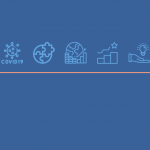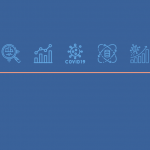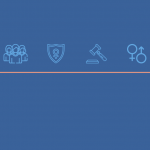Summary
• Continuity of education and learning during COVID-19 is critical to Pakistan’s socio-economic development; hybrid learning models offer a solution to this challenge.
• The digital divide in Pakistan is widening pre-existing gaps in opportunities available to students from disadvantaged backgrounds.
• Digital access is a multi-pronged problem: low device penetration, affordability of internet, and poor experience in remote and rural
Pakhtunkhwa are most affected by limited digital access.
• Response from universities must be inclusive and dynamic to cater to the evolving challenges during the multi-wave pandemic; ensure equal opportunities for all groups.
• Policymakers should focus on bridging the digital divide and ensuring learning continuity by improving digital access, smooth transition to hybrid learning models and welfare support for students to adjust to the disruptions.
Digital Education and its Challenges in Pakistan
Education institutions globally have resorted to distance learning models facilitated heavily by digital sys-tems to cope with safety precautions in the COVID-19 pandemic. Universities in Pakistan are no exception and have been compelled to move towards digital learning. This nascent transition is dominated by three key issues:
- Capacity and readiness of teachers to provide a quality learning experience using distance and digital modes of education.
- Limited penetration of devices (computers, laptops, tablets and smartphones) and poor internet coverage and experience in remote and rural areas [i].
- Disruptions in learning and uncertainty lead to dropouts which affect the economy at large, and increase pressure on vulnerable segments like females and migrants.
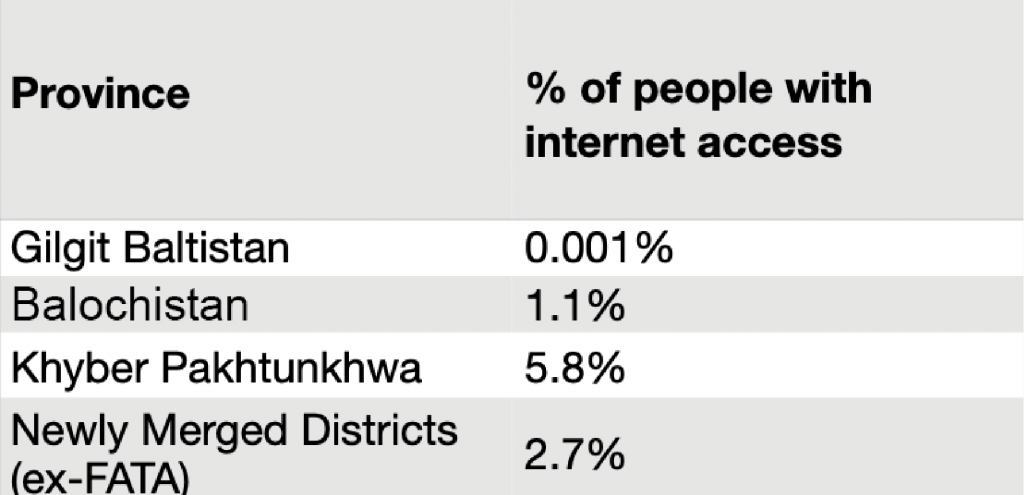
British Council: Percentage of people with internet access
Remote and rural areas have experienced an inadequate flow of investment in broadband internet services over the years. This has resulted in the lack of a decent broadband experience, fixed and mobile, that can enable increased adoption of high bandwidth use-cases like accessing videos and online content necessary for virtual classes and lectures [ii]. Moreover, affordability of the internet, low laptop and computer penetration [iii], and taxation on smartphones also contribute to a widened digital divide that compromises availability of online learning opportunities. Female students are at an even greater disadvantage given Pakistan has the widest gender gap in phone ownership globally [iv].
Policymakers and universities thus far have been unable to devise an effective, inclusive and responsive framework to ensure learning continuity amidst the uncertain lifecycle of the COVID-19 pandemic. Such a response must be constituted through a participatory process involving all stakeholders: students, parents, teachers, and the health community.
Why technology alone will not solve the learning challenge
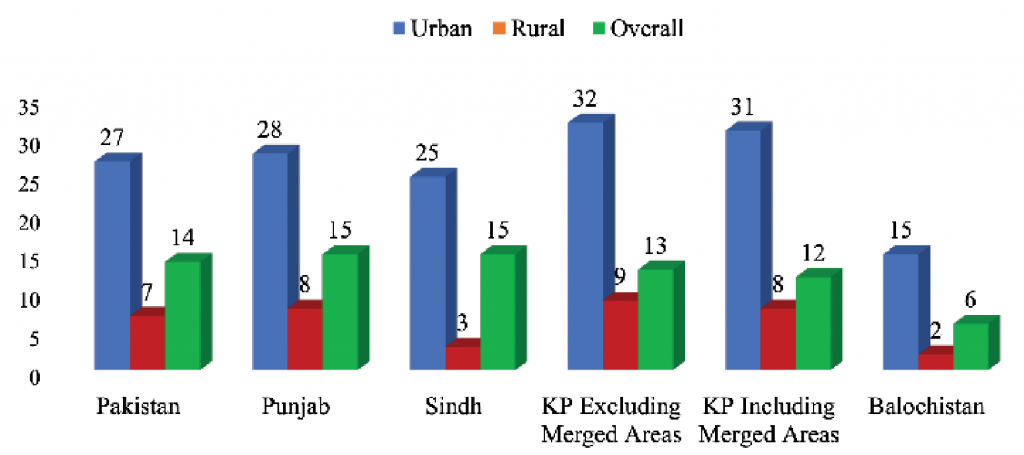
Household with At Least one Computer/Laptop/Tablet
According to Economist Intelligence Unit’s Inclusive Internet Index 2020, Pakistan ranks 76 out of 100 countries in digital inclusivity, and 24 out of 26 in Asian countries. This score comprises of indicators on availability of internet, affordability of internet, and relevance of content. The digital divide that adversely affects education in Pakistan can be attributed to:
- Drastic variance in broadband internet coverage and experience (bandwidth) across different parts of Pakistan especially in rural and remote areas
- Economic disparity and compromised affordability of internet services by low-income groups especially during the pandemic when income levels have gone down for Pakistani households
- Security risks and challenges in sensitive border areas of Balochistan and KP have resulted in non-provision and extended shutdowns of internet and electricity
Data reported by the Pakistan Telecommunication Authority (PTA) in August 2020 shows that only 41% of population in Pakistan have access to broadband. Despite 92% land coverage and more than 60% mobile broadband (3G/4G) coverage, the low penetration is a manifestation of cost and experience limitations of using mobile broadband. The use of broadband as a primary source of internet for education is thus not a realistic option for most Pakistanis, especially those that need such access the most.
Disruptions to learning caused by COVID-19 have exposed pre-existing inequalities and conditions that plagued education in Pakistan. The education system has been unable to address issues of universal and quality education, and the gaps in education haves and education have nots are further exacerbated by the gentrification of neighbourhoods, under-utilised education technologies, lack of qualified teachers and ineffective teacher training regimes for decades. The sudden shift to digital learning has also been an obstacle for teachers. Most teachers do not have the requisite levels of digital readiness and technical knowledge to deliver an optimal digital learning experience, and the level of investment in their capacity has historically not been designed to address this vacuum.
Implications of Learning Discontinuity
Only 9% students from secondary education transitioned to universities in Pakistan in 2018, making it one of the lowest transition rates in in South Asia, compared to 21% in Bangladesh, and 29% in India . Most students that successfully make this transition tend to be from the urban centers and high-density regions across the country, especially the Punjab . ‘Migrant students’ from rural and remote areas move to cities to access better education infrastructure and opportunities. The highest number of students that are admitted to universities on seats reserved for students on the basis of geographical background come from Balochistan, Gilgit Baltistan and Khyber Pakhtunkhwa. Low transition rates to tertiary education drastically compromise human capital development thus translat-ing into labour markets with low or unskilled workers, and a weak footing to boost economic growth. Discontinuity of university education or seriously compromised learning may lead to student dropouts and early entry in the labour market without the requisite skills. Gearing up for an economic recovery from Covid-19 will require a lead time and interim economic conditions will not offer worthwhile opportunities to those that lack skills. An inclusive approach and response to education during COVID-19 is therefore critical to ensure that pre-existing inequality is not deepened and perpetuated through the various challenges students face in accessing higher education.
Another important aspect of the risks to higher education penetration caused by the Covid-19 crisis is the confinement and restrictions faced by females due to prolonged interruption in education. Women are especially vulnerable to abuse, forced and early marriages, and dropouts. Females face an additional layer of pressure through expectations to service domestic chores alongside online classes. Such pressures increase the risk of student dropouts especially in the absence of welfare support, including counselling and monetary support.
Issue
Recommendations
1
Limited penetration of devices (computers, laptops, tablets and smartphones) and poor internet coverage and experience in remote and rural areas.
Optimize In-person and Digital Learning: Students unable to attend online classes should be given an option to access university premises, and use computer and internet facilities on campus for access to remote classes— subject to strict enforcement of distancing and precautions protocols, including mask use. Video instructions should be pre-recorded and added to the ‘lecture pack’ to ensure that Frequently Asked Questions (FAQs) are provided with answers.
Bridging the Digital Divide: The COVID-19 Committees, and the Standing Committee on Information Technology and Communication may engage the relevant ministries and departments, including the Ministry of Federal Education and Professional Training, the Ministry of Information Technology, the Higher Education Commission, provincial education and higher education departments, Federal Bureau of Revenue (FBR), Pakistan Telecommunications Authority (PTA) and USEF, to collaborate on bridging the digital divide through improving access, experience and affordability of the internet. Investment in digital and technological infrastructure in remote and rural areas by increasing the fiber optic footprint and/or mobile broadband coverage/bandwidth and special pricing for educational content can help improve accessibility of avenues for learning. High taxation levels on the telecom industry may need to be revisited as most are passed on, indiscriminately to all Internet users, increasing the costs of connectivity and lowering access in the bargain.
Developing Learning Centers: Learning centers with high speed broadband connectivity should be established in all regions where digital access is an issue. These centers can help bridge gaps in access by providing local hubs for connectivity. Funds should be allocated for a rapid execution of this initiative and recurring provisions included in the HEC budget for subsequent years.
2
Disruptions in learning and uncertainty lead to dropouts which affect the economy at large, and increase pressure on vulnerable segments like females and migrants
Welfare and Wellbeing Support: There is a risk of students dropping out in an atmosphere of uncertainty. It is necessary that students at a high risk of dropping out, especially those from marginalized backgrounds, religious and ethnic minorities, and females, are proactively offered support and counselling free of cost.
Participatory Communication System: It is essential that university management openly communicates with parents, students, and teachers to ensure a participatory process for formulation of responses. Information provision to all stakeholders must also be tailored to the audience and made available clearly and in a timely manner.
Localized Decisions: In the event of a surge in COVID-19 cases where universities have to make urgent decisions, it is vital that they coordinate with important actors, specifically the local administration and health community in order to access and assess information, source expert advice and implement relevant measures related to SOPs, reopening and reclosure to ensure learning continuity.
3
Capacity and readiness of teachers to provide a quality learning experience using distance and digital modes of education
Redirecting and Raising Funds: A strong demand for increasing the national allocation for education budget to improve infrastructure, access and capacity of teachers should be put forth by federal and provincial departments. These funds should also be used for sup-port welfare allowances and emergency spending to avoid learning losses.
Sources
- BR Research, ‘On Broadband Uptake’. Business Recorder, Oct 23, 2019.
- Roger Jeffery, Jon Oberlander et al, ‘Digital Citizenship in Pakistan’. University of Edinburgh, British Council.
- Government of Pakistan, ‘Pakistan Social and Living Standards Measurement Survey (2018-2019): National/Provincial (Social Indicators)’. Pakistan Bureau of Statistics, June, 2020. p. 62.
- Higher Education Commission, Pakistan. ‘HEC Recognised Universities and Degree Awarding Institutions’.
https://www.hec.gov.pk/english/universities/pages/recognised.aspx - International Baccalaureate, ‘Online Learning, Teaching and Education Continuity Planning for Schools’. Policy Brief, Mar 2020.
- Rasul B. Rais, ‘Pakistan’s Shift to Online Learning During pandemic Raises Various Class Issues’. Arab News, Jun 28, 2020.
- Robert Hunter, ‘Education in Pakistan’. World Education Services, Feb 25, 2020.
- Tariq A. Saeedi, ‘Pakistan’s Gender Gap in Mobile Phone Ownership, Usage Widest in World’. The News, Mar 6, 2020.
https://www.thenews.com.pk/print/624556-pakistan-s-gender-gap-in-mobile-phone-ownership-usage-widest-in-world-gsma - Mehreen Zahra-Malik, ‘The Coronavirus Effect on Pakistan’s Digital Divide’. BBC, Jul 14, 2020.
https://www.bbc.com/worklife/article/20200713-the-coronavirus-effect-on-pakistans-digital-divide - Nasir Jamal, ‘Another Exercise in Futility?’. Dawn, Oct 27, 2020.
https://www.dawn.com/news/1586967/another-exercise-in-futility - Salman N. Khan and Sana Kazmi, ‘Pakistani Teachers’ Response to COVID-19’. Policy Brief, Pak Alliance for Maths and Science and Zindagi Trust, 2020.
- United Nations, ‘Policy Brief: Education during COVID-19 and Beyond’. Aug, 2020


